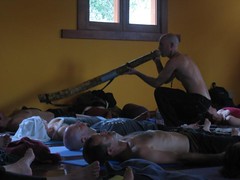20 minutes ago #5
I wave my didjeridoo to the 15 or so folks still left at the gathering of vloggers signaling my readiness to begin playing in the dojo. Everyone seems to take note and sure enough, in 5 minutes, we are all in the high-ceilinged studio. Markus sets up the microphone and PA and then splashes some colors up on a projection screen strategically hanging behind me. The sound check becomes the performance and I immediately start chanting om ah hum, om mani padme hum, om gati gati, para gati, para sumu gati, bohdisvaha. Next I sing Running to Stand Still thru the didge and then go into a shortened version of Road House Blues. Poly phonic dog barking, pressing my cheek for rhythms, overtoning harmonics, high pitched toning and then back to chanting… One continuous out breath for around 30 minutes. When I finish, I am pleasantly surprised by the warm and attentive reception by the small audience of vloggers. The first question is: How does the playing affect you? I answer the question in a very round about way: I feel clear, like my hemispheres are synchronized. You know, I find it quite interesting that the Aborigines, in general, discouraged women from playing the didge because they felt women held an advantage and the men playing it evened the playing field. The reason I find this interesting is because of the research that has been done on mirror neurons… Does anyone here know what mirror neurons are? {no answer} Well, mirror neurons are dedicated to discerning the emotional states of other humans through facial expressions and body language and then allowing the observer to feel what the other one is feeling – empathy. What they learned was that women use both temporal lobes while men tended to just use the left one. Women also used their white matter while men used their grey matter. A major difference between men and women is the corpus callosum.
http://en.wikipedia.org/wiki/Corpus_callosum

http://en.wikipedia.org/wiki/Corpus_callosum










0 waves:
Post a Comment
<< Home